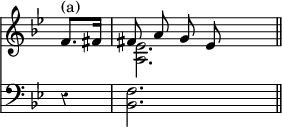A Dictionary of Music and Musicians/False Relation
FALSE RELATION is the occurrence of chromatic contradiction in different parts or voices, either simultaneously, as at (a), or in chords which are so near together that the effect of one has not passed from the mind before the other comes to contradict it with a new accidental, as at (b).

The disagreeable effect is produced by the contradictory accidentals belonging to different keys, or unequivocally to major or minor of the same key; and it follows that when the contradiction is between notes which can coexist in the same key the effect is not disagreeable. Thus chromatic passing notes and appoggiaturas do not affect the key, and are used without consideration of their apparent contradictions. Schumann uses the sharp and natural of the same note in the same chord in his 'Andante und Variationen' for two pianofortes, op. 46 (a), and Haydn the same in his Quartet in D, op. 71 (b).


Again, notes which are variable in the minor key do not produce any objectionable effect by their juxtaposition, as the minor 7th descending and the major 7th ascending or stationary; thus Mendelssohn in the Overture to 'Ruy Bias' has B♭ and B♮ in alternate chords.

And the treatment of notes which are inter-changeable in chromatic and diatonic chords in the same key is equally free, as between a chromatic note of the chord of the augmented sixth and a succeeding diatonic discord.
